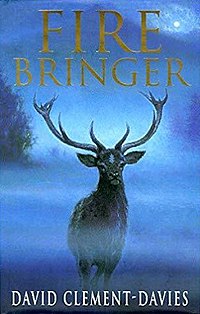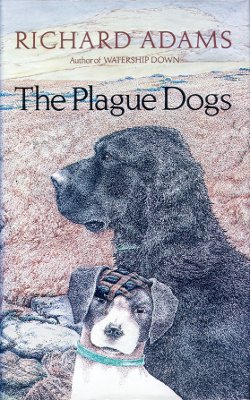8/30/2000
 |
| Elliot O'Donnell |
Elliott O’Donnell’s Great Ghost Stories ed. Harry
Ludlom
[Note: collection of “true” ghost stories]
Strange
how so many of the tales concern jealous women killing their rivals or evil
women committing some troubled or misdeed.
They are far more common then the stories with men doing such
things. Is this because the stories
started with men or are being retold by men?
It is also interesting to see how these “true” tales have influenced
Victorian writers. Once can see the gem
of an idea that might have sparked Dickens’ or another’s imagination. The book is good because it veers away from
the more famous places, dealing more with the ghost stories concerning the
middle-class.
9/1/2000
Firebringer by David Clement Davies
[Note: novel about deer in prehistory]
It seems
that most animal books must always make man the enemy or the villain. Howard and Jacques [Redwall] being the
expectations. What would the deer say if
they knew men worshipped Herne?
The
strange deer in Chapter nine are like the rabbits in Watership Down. Why is the chosen one always male in novels
and movies? There are very few
exceptions and the exceptions must always be saved by men. Women give birth to the chosen one but that
is it unless the romantic lead.
Why make
Willow twin? Peppa seems so
non-existent. Willow herself is not a
very complex character. Characters are
very cardboard like. No reason why
Ronnock is so attractive for Willow and the love interest among the deer
doesn’t quite work.
The
novel is too episodic and too much like Watership Down.
Also how
come wolves and foxes are considered dangerous but the other predators are
not. Snorr’s control is too unrealistic
especially when he attacks the non-deer.
Isn’t strange and disquieting that a seal talks to the fish it
eats? The line about animals not
understanding men seems silly considering domesticated animals.
9/4/2000
The Plague Dogs by Richard Adams
[Note: this is a difficult book to read if you have dogs. There is also a movie, and if Watership Down traumatized you, you might want to avoid it. ]
I
love the fact that A.R.S.E are the bad guys. [Note: animal testing company]
The
description of the newspaper is interesting, “ . . . indicted and vindicated
all over the world, watchdog of liberty, cat’s cradle of white-collar banality, ram’s horn of soft pornography,
crocodile’s tear of current morals, gulf and maw of the . . .(189-190).
Description
of an actress, “who some little time ago opened the building as effortlessly as
her legs . . . “(190).
Newspaper
men portrayed as stupid. Take for
instance the emphasis on a dog killing a man with a gun instead of the dog
killing the sheep. They make it sound like the dog really shot the man. It is
unclear why Ephraim doesn’t have the safety on gun. Parts of the book seem coincidental.
I like
the explanation of dogs and cats in the dog version of Adam and Eve, “When the
man was disgraced and told to go away, he was allowed to ask all the animals
whether any of them would come with him
and share his fortune and his life.
There were only two who agreed to come, entirely of their own accord and
they were the dog and the cat. And ever
since then, those two have been jealous of each other, and each is forever
trying to make man choose which he likes best.
Every man prefers one or the other.” (161).
The
police drive a Jaguar?!
The book
also turns on journalism. Driver does
some good, but he also stirs up the people with little or no proof of his
accusations. He makes Rawof’s and Smitter’s
place periallous. They’re repeatedly desired
by Driver who saves them from the men with the guns, but who also hinders
they’re attempt to find home. Driver is
also not a good listeners as he missies Moss’s slip when she refers to her
brother, nor does her thoroughly check out the background information.
No
mention of Wescott’s gun.
The
introduction to the parliamentary debates interrupts the flow of the
novel. Perhaps the periodic nature of
some of the sections/chapters is made to resemble Smitter’s brain and how it
jumps around. At times, the narrative
voice is very close and at other it recedes.
The narrator does help you bond to the dogs. With the expectation of Smitter’s master, the
highly professional people (docs, reporters) are portrayed in unflattering
lights. The middle-class people, the Lancaster
shire men are portrayed as the good men.
This is especially detailed because the characters are drawn from
life. Is this class conflict? The dog hunt would have gone better without
the newspaper men.
Also
A.R.S.E does not do serious medical research (cancer say) most of the
experiments are shown to be not only
cruel but unnecessary.. This way Adams has
all the readers on the dog’s side. It
legitimate medical research were occurring then the line would be more blurry. Not sure how I feel about animal testing.
The book
shows the fine art of ass covering in
the ranks of A.R.S.E. Additionally
there is also commentary on the treatment of stray animals. (Glad I gave that cat water). Two reasons why the book has to be set in
rural district: (1) sheep (2) lack of human contact.
The
beginning of the book, with Tyson and Lancaster’s
opinions in general about non-working animals explains the lack of soft
feelings that some characters have over the course of the book. [Note- this is like Joyce Stranger’s work
as I would rather discover]. There
is grief over losing a working animal, though.
Driver
recognizes Moss’s cruelty but is more
upset at being lied to.
She really is a cold hearted bitch!
To
Driver’s credit he does try to do the right thing. He is not entirely bad. He has a shade of grey.
Poor
Smitter.
He does
deal with Stephanie and so covers both sides of the issue. Powell is kinder and has a better understanding
of the situation than Boycott.
Redemption
of Driver is done via the dogs.
Fairy
tale like in telling. Adams is showing
difference between Read and Boycott. It
becomes a part moral fable at the end.
Whole book seems structured as a fable.
I wish
we were told if the farmers got paid for the killing of their sheep. But I suppose that would ruin the happy
ending.
It is
different than Watership Down, the narrator is more present and engages the
reader at times. At times the reading
feels too distanced from the characters and the ending is almost too pat.


Comments
Post a Comment